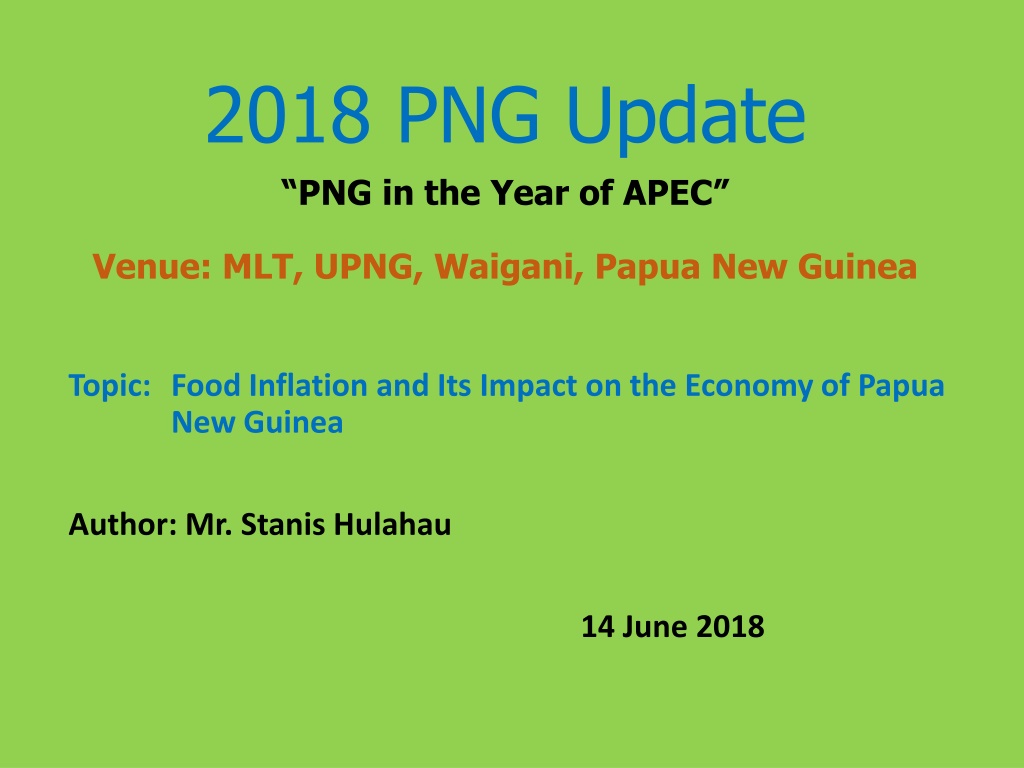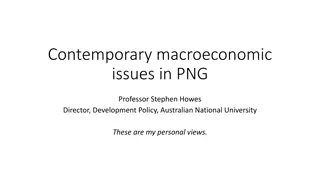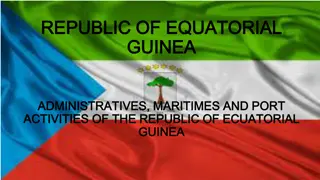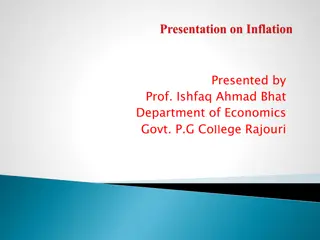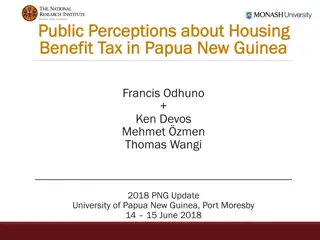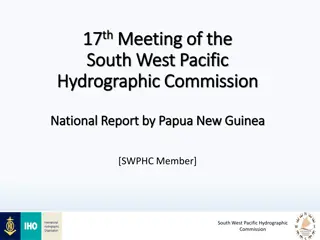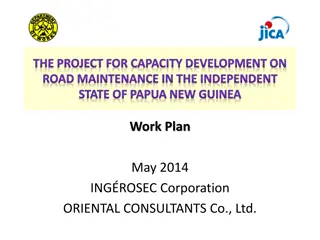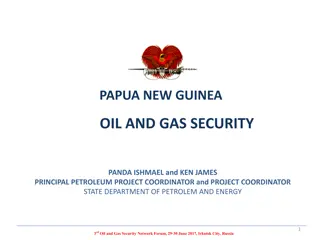Food Inflation and Its Impact on Papua New Guinea's Economy
Understanding the challenges of food inflation and its impact on consumers and the economy in Papua New Guinea is crucial. Despite GDP growth, the country still faces issues due to high demand for food and limited domestic production. Import dependency and insufficient domestic food industry hinder the management of food inflation, affecting households and markets.
Download Presentation

Please find below an Image/Link to download the presentation.
The content on the website is provided AS IS for your information and personal use only. It may not be sold, licensed, or shared on other websites without obtaining consent from the author. Download presentation by click this link. If you encounter any issues during the download, it is possible that the publisher has removed the file from their server.
E N D
Presentation Transcript
2018 PNG Update PNG in the Year of APEC Venue: MLT, UPNG, Waigani, Papua New Guinea Topic: Food Inflation and Its Impact on the Economy of Papua New Guinea Author: Mr. Stanis Hulahau 14 June 2018
Outline Introduction Problem Research Questions Research Objectives Summary of Literature Review Data Methods Findings Recommendations
Introduction Every humans eat food. Therefore every person is affected by food inflation. This dilemma has constantly challenged consumers and governments across the world. Understanding food inflation and its impact on consumers and the economy are significant matters for governments and policy makers of developed and developing countries, Inflation is widely known as the general rise in the price of goods and services over a period of time, while reducing each unit of currency one holds to buy fewer goods and services. In the same vein, food inflation which is the focus of this paper occurs when prices of food items rise, influenced by the increase in the aggregate quantity of food demanded which is greater than food supplied at a particular time, (World Bank, 2008). With the impulsive nature of world commodity prices, especially with the volatile characteristics of food inflation, consumers across the world are left vulnerable to endure the impact of food inflation. Despite an exponential growth in GDP since 2002 attributed to a favourable world market price of minerals and a stable economy, Papua New Guinea (PNG) has not been spared from the dreadful effect of food inflation. PNG as a member of the global community has experienced her fair share of food inflation episodes. The increase in the demand for staple and processed food with an ongoing scarcity in food supply in the economy has been a major challenge for PNG consumers, policy makers and the government. To manage this dilemma, the country has been consistently dependent on imported food hence becoming one of the leading net importer of food in the Asia Pacific Region, (UNDP, 1997, p. 178-9). Graphs..
Problem According to UNDP (1997) PNG is one of the leading net importer of food in the Asia Pacific Region, The on-going challenge is that the production and supply of domestic food products such as cassava, banana, sweet potatoes including animal products and sea foods are inconsistent and usually supplied on a small scale, barely adequate to meet the households growing demand for food, The current practice is that the domestic food are produced by individual rural farmers for their own households consumption while selling the surplus randomly in the local food markets for extra cash, There are no economies of scale in domestic food production, supply and distribution PNG s domestic food industry is not well developed to cater for the rapid increase in food demand, There is also lack of food substitutes such as backed, salted, dried and smoked food products that could be widey and promptly accessed by consumers to cushion the excess demand on certain food products,
Cont Given the internal demand and supply challenges in PNG and the effects of external demand and supply shocks including global food price fluctuations in the volatile commodity markets, there has been persistent hike in food prices in the country which has not been adequately documented.
Research Question What are the factors that impact food inflation and its impact on the economy of PNG?
Research Objective The primary objective of the study was to identify the factors that impact food inflation and ascertain its impact on the economy of PNG, The secondary objectives were; - To determine the long and short run relationship (causality) between the variables that positively or negatively influenced food price inflation, - To determine the long and short run relationship (causality) between food inflation and real Gross Domestics Product, - Propose key policy options at the strategic and sectoral level in PNG to deal with food inflation in the country.
Summary of Literature Review A set of publications in the area of food inflation and the economy were reviewed and documented, They ranged from reviewed scholarly papers, government reports, conference papers, books, journals, research papers produced by World Bank, Asian Development Bank, Institute of National Affairs, Bank of PNG and Food Agriculture Organisation (FAO), The literature provided a scenario of global food inflation based on various studies conducted both in the perspective of developed and developing countries by other researchers and drawing the lessons and relevance of those studies as a guide in this study, Abbott et al. 2008, Baltzer et al. 2008, Dewbre et al. 2008, Helbling et al. 2008, Schnep (2008), Trostle (2008), Von-Braun, (2008), Yang et al. 2008, in their empirical studies concluded that global food inflation was triggered by economic factors including low interest rates, escalating oil prices, hike in the demand for biofuel production, depreciation of major currencies, significant income growth in populated countries, low food stocks, high fertilizer prices, and domestic policies (export restrictions, embargoes and market structures) including weather shocks, According to OECD-FAO: 2008, food prices rise when markets get tight while production shortfall (shock) in itself is enough to send prices higher rather than the effects of monetary policy regimes.
Lit Rev Cont A fascinating aspect of food inflation is the disparity in food prices and consumption pattern in the developed and the developing countries, In the well-developed and advanced economies, food inflation is relatively lower than food price hike in the developing countries. In their study, Schnepf and Richardson (2011) revealed that the lowest 20 percent of US households quintiles in 2009 spend 16.2 percent of their household income on food while the food budget share decline across income quintiles until the wealthiest quantile, where households spend an average of 11.4 percent, The status quo is further complicated when comparing food prices in developing countries that are well-developed emerging economies to those that are underdeveloped and volatile economies, Food inflation in the underdeveloped and volatile economies are higher than the well-developed emerging economies, Average household in developing countries still spend almost half of their household income on food. Miskelly et al. 2011, in their study proved that the share of average household income spend on food in the Developing countries ranges from 35 to 40 percent (40%). Food inflation is relatively high in developing countries as most of them rely on imported food. China s single most problem as a developing economy is food inflation. About 75 percent of China s overall inflation rate is due to high food prices , (Matt Phillipps, 2010).
Lit Rev Cont Tang (2001) analysed Malaysia s food inflation using the unrestricted error correction model (UECM) and concluded that the factors impacting Malaysia s inflation were import price and real- income variables, Holod (2000) and Leheyda (2005) in their separate studies examined factors impacting food price hike in Ukraine and revealed that real output, exchange rate, money demand and supply and wages are key drivers impacting price hike in Ukraine, In India, there were three pivotal factors that impacted food inflation in the country. Gulati and Saini (2013) in their research concluded that the transmission of the global food inflation, ballooning/monetized fiscal deficit and the rising farm wages explained 98 percent of food variation in India s food inflation over the period of 1995 to 2012, In the Asia Pacific region, various studies have been conducted on inflation and high food inflation. According to Min et al. 2006, the region encompasses developed economies, small and vulnerable economies with least developed countries (LDCs) and developing countries that are net food importers and net food exporters, In the Asia Pacific region, various studies have been conducted on inflation and high food inflation. According to Min et al. 2006, the region encompasses developed economies, small and vulnerable economies with Least Developed Countries (LDCs) and developing countries that are net food importers and net food exporters, According to FAO (2007), Pacific Island countries rely heavily on food imports with increases on annual rate of 20.3 percent in Cook Islands, 14.4 percent in Fiji, 7.7 percent in Kiribati, 16.7 percent in the Federated States of Micronesia, 16.4 percent in Niue, 2 percent in Papua New Guinea, 26.4 percent in Samoa, 23 percent in Solomon Island, 0.33 percent in Tonga and 8.6 percent in Vanuatu. Food comprises approximately 45 percent of PICs consumer price index basket placing the PIC overall in a position similar to Asian LICs and well above the average for emerging market economies , (IMF, 2011).
Lit Rev Cont Factors such as depreciation of major currencies, dwindling food stocks, hike in fertilizer prices, low interest rates, government policies such as export and import tariffs, production of bio fuel, money supply, rapid income growth in emerging economies, rising demand from middle class in developing countries and natural disasters (weather shocks) are key determinants of food and non-food inflation, PNG according to World Bank (2014) is dominated economically by two major sectors, a small formal sector focussed primarily on the extractives and the export of renewable resources and an informal sector employing majority of the population. Rogers et.al (2011) revealed that eighty seven percent (87%) of people in PNG live in rural areas, which technically equates to the bulk of the population occupying the informal sector and engaging in subsistence agricultural and small holder cash crop farming to generate income opportunities and maintain their livelihood, Given the status quo and the lack of diversification and transformation in economic activities in order to hedge against global commodity price shocks, PNG s economy remains susceptible to the effects of food inflation. It is important to mention that there are no studies conducted specifically on examining the effects of food inflation on the economy of PNG even though it is a significant macroeconomic phenomenon posing threat to economic growth and the main determinant of underlying inflationary pressure in the country
Data Secondary data were used in this study and were collected from various credible organisations PNGNSO, ADB, FAO and World Bank, including BPNG, The data included the Consumer Price Index (CPI), Real Interest Rate, Real Exchange Rate, Money Supply, Wheat Price and Gross Domestic Product (GDP), The data were distilled and codified to ensure accuracy, genuineness and completeness in order to be used,
Methods Various statistical techniques were used in this paper. To show the general trend in price and food price inflation in the country from 2001 to 2011, descriptive statistics was employed, Unit Root Test using the Augmented Dickey Fuller (ADF) method was employed to test the characteristics of the data. Economic variables in time series are often non-stationary and have unit root which implies that the data points have means, variance and covariances that change over time and behave in cycles, trends, random walks or combination of the three. Non-stationary data are unpredictable and cannot be modelled or forecasted as it may indicate a relationship between two variables where one does not exist. Therefore the application of Johansen Cointegration Test and the ADF test are appropriate in this analysis. The corresponding results of the ADF unit root and stationarity test will further inform the use of cointegration analysis and error correction model in analysing economic time series data, To examine the determinants of food price inflation in PNG, a parsimonious food inflation Error Correction Model (ECM) was employed. Based on the demand and supply side inflation model as food inflation and its determinants are cointegrated (Greene, 2012). ECM was also used to determine the effects of food price inflation on the economy of PNG, In both ECM models, economic time series data were used which were nonstationary and has unit root hence appropriate tests were employed to differenced the variables in order to remove build-up of errors and obtain valid results.
Methods Cont Test of Cointegration was used in this study to analyse whether the variables were integrated of the same order or have a linear combination and integrated of the same order or a lower order. Macroeconomic variables or economic time series data points tend to trend up or down in the short and long run hence the cointegration test will reveal whether there is a possibility for linear relationship among the set of variables used over long term periods, If such a stationary I(0) or linear combination exists, the nonstationary (with a unit root), time series are said to be cointegrated and the stationary linear combination is interpreted as a long-run equilibrium relationship between the variables (Makaiko, 2008). Therefore the cointegration test offers a two dimensional approach of segregating the evolution of time series data into long-run equilibrium characteristics (the cointegrating vector) and the short run-run disequilibrium dynamics (Psaradkis et al 2004). The Error Correction Model is mostly used in the multiple time series data analysis where variables have long-run stochastic trend or known as cointegration. ECM are useful for estimating both long-run and short-run effects of one time series on another and essentially estimates the speed a dependent variable returns to equilibrium after a change in the other variables. Therefore after the ADF and Johansen test were used to establish the existence of cointegration, ECM was ideal in this study to estimate both the long-run and short-run speed to which a dependent variable returns to equilibrium after a change in the other variables.
Methods Cont The simplified model for factors affecting food inflation in PNG ??= ? + ?1????+ ?2?? ?+ ?3????+ ?5??? ???+ ? ?? VECM: ? 1 ? 1 ? 1 ? 1 ??= ? + ? ? ???+ ?? ?? ?1,? ???? ?+ ?2,? ?? ? + ?3,? ???? ?+ ?5,? ?? ? ?=0 ?=0 ?=0 ?=0 Where; ??= ???????? ????? ????? ??? ???? ?? ????= ???? ??? ???? ???? (????? ?? ??? ???? ?????????? ?? 1??$ ?? ????= ???? ???????? ???? (%) ??? ???= ? ??? ????? ?? ??$ ??? ????? ??= ??????? ?????? ????? ???? = ??????? ????? ?????????? ???????? ?= ????? ?????? ?? ??? ???? ???????? ?? ????
Methods Cont The simplified model for impact of food inflation on the Economy of PNG ??+ ?? ? 1?1,? ???? ?+ ?=0 ? 1?3,? ???? ?+ ?=0 ? 1?5,? ?? ? ??= ? + ?=0 Where; ??= ???? ????? ???????? ??????? ?? ??? ???? ????= ???? ??? ???? ???? ????= ???? ???????? ???? (%) ??= ?????? ???? ?? ? ???? ?? ???????? ????? ????? ??? ???? ?? ??= ?????? ????? ???? = ??????? ????? ?????????? ????????
Findings Factors impacting Food Inflation There is a long run relationship (causality) between the variables real exchange rate and wheat price which significantly influenced food price inflation in PNG, In the short run, real exchange rate, money supply, real interest rate and wheat price do not significantly affect food inflation, Factors impacting the Economy of PNG There is a long run positive relationship or causality between GDP, real exchange rate, real interest and food inflation, Therefore the overall findings of the study using the vector error correction model revealed that food inflation is caused by long run relationship among the study variables and food inflation has a long run relationship with real GDP.
Recommendation The study results revealed that food inflation is a significant determinant exerting underlying inflationary pressure on headline inflation in PNG. Food inflation is mostly caused by the appreciation (depreciation) of Kina exchange rate and imported food and food items as illustrated by the variables real exchange rate and wheat price. Therefore at the strategic level, there is a need to review the Food Security situation of PNG with the view to embark on increasing the domestic food production and supply to meet the growing food demand in the country while limiting food imports, Prudential management of Monetary and Fiscal policies is necessary to manage exchange rate while a broader management of Macroeconomic Policy will ensure the internal and external determinants of food inflation is effectively managed.
